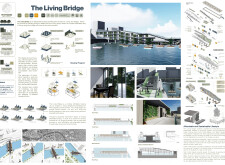5 key facts about this project
Functionally, the primary objective of The Living Bridge is to create a series of modular housing units along the structure, transforming it into a living ecosystem. These units cater to a diverse demographic, offering various configurations that meet the needs of individuals, families, and communal activities. Each housing unit is equipped with amenities that enable comfortable living while maintaining a connection to the surrounding environment.
One of the project’s key elements is its focus on sustainability, embodied through carefully designed hydroponic systems that empower residents to grow their own food. By incorporating natural agriculture into the living spaces, this design approach promotes a self-sustaining lifestyle, enabling residents to engage more directly with their food sources while fostering a sense of community through shared gardening experiences.
The Living Bridge also prioritizes public interaction by integrating communal spaces. These areas are thoughtfully arranged to encourage activities such as walking, socializing, and engaging in recreational pursuits. The idea is to create an accessible environment that seamlessly marries the individual needs of residents with the larger community’s social fabric.
Water management systems are a noteworthy feature of the project. The design includes advanced solutions for rainwater harvesting and recycling, enhancing the ecological sustainability of the development. By utilizing these resources efficiently, The Living Bridge minimizes its overall water consumption, setting a standard for future urban developments.
The architectural design employs a thoughtful selection of materials, focusing on both function and aesthetic appeal. Reinforced concrete serves as the backbone of the structure, providing the necessary strength and durability for a bridge. Extensive use of glass introduces natural light into the living environments, creating a sense of openness and connection to nature. Wood is used for interior elements and outdoor decking, offering warmth and a tactile quality to the spaces. Metal components are also integral in providing structural support while reflecting a contemporary design aesthetic.
What truly distinguishes The Living Bridge is its dual role as infrastructure and community space. Unlike traditional bridges, which typically serve a singular purpose, this project reimagines the potential of urban structures. By serving as a nexus for residential life, the design showcases innovative architectural thinking that responds to modern urban challenges.
As with any architectural endeavor, there are many layers to The Living Bridge that merit exploration. From its architectural plans that illustrate the spatial arrangement to architectural sections that detail the structure’s integrity, careful examination of the design elements reveals the depth of thought and planning that has gone into its conception. For those interested in contemporary architectural ideas, a visit to the project presentation can provide valuable insights into its innovative features and overall vision. This exploration not only enhances understanding but also sparks inspiration for future urban projects that prioritize community living and sustainability.























